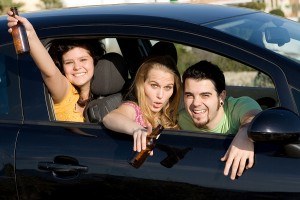 While New Year’s Eve may conjure images of a celebratory toast, it’s also traditionally one of the worst days of the year for alcohol-related car crashes and deaths for young drivers.
While New Year’s Eve may conjure images of a celebratory toast, it’s also traditionally one of the worst days of the year for alcohol-related car crashes and deaths for young drivers.
New data from a 2011 teen driving study by Liberty Mutual Insurance and Students Against Destructive Decisions (SADD) reveals an interesting yet cautionary anomaly: teens believe New Year’s Eve is the most dangerous time of year to drive, yet it also is the holiday or event when teens most frequently drive under the influence of alcohol or other drugs.
According to the survey of nearly 2,300 eleventh and twelfth graders, when teen drivers were asked about how dangerous they feel certain events are for driving and the likelihood of driving under the influence of alcohol or drugs on one of these events, New Year’s Eve topped both lists.
| Holiday/Events | % of teens that view event as very/extremely dangerous to drive |
% of teens that have driven under the influence of alcohol or drugs after one of these events |
| New Year’s Eve | 49 percent | 10 percent |
| 4th of July | 29 percent | 8 percent |
| Prom Night | 20 percent | 6 percent |
| Graduation/Post Graduation | 16 percent | 4 percent |
| Homecoming | 11 percent | 6 percent |
| High School Football Games | 8 percent | 6 percent |
| Other School Dances/Events | 8 percent | 5 percent |
The silver lining? Passengers have a powerful influence over drivers.
The large majority of teen drivers say that they would stop driving under the influence of alcohol (94 percent) or marijuana (90 percent) if asked by a passenger. Interestingly, teen passengers say they would be significantly more likely to ask a peer to stop driving after drinking than after using marijuana (87 percent vs. 72 percent), and female passengers are more likely to speak up against either driving behavior than boys (90 percent vs. 83 percent for alcohol; 78 percent vs. 65 percent for marijuana).
“New Year’s Eve is a time to celebrate both the past year and the possibilities of the year to come, yet far too often poor decisions by teens result in tragic injuries and deaths,” said Stephen Wallace, Senior Advisor for Policy, Research, and Education at SADD. “To avoid a fatal start to the New Year, teen passengers need to use their voices if they have concerns about their friends’ behaviors. They will be heard.”
The study was initiated with a series of four focus groups held in Harrisburg, Pa., and San Francisco, Calif., in October 2010, followed by a survey of 2,294 teens in eleventh and twelfth grades from 28 recruited high schools across the country in January 2011. Overall findings for the study can be interpreted with a 95 percent confidence interval with an error margin of +/- 2.02 percent.
Source: Liberty Mutual Insurance and SADD
Was this article valuable?
Here are more articles you may enjoy.

 Oracle Tells Clients of Second Recent Hack, Log-In Data Stolen
Oracle Tells Clients of Second Recent Hack, Log-In Data Stolen  Hedge Funds Are Hunting Deals in Risks Too Big for Insurers
Hedge Funds Are Hunting Deals in Risks Too Big for Insurers  VW, Stellantis, Renault Among Firms Fined $495M Million by EU
VW, Stellantis, Renault Among Firms Fined $495M Million by EU  Deutsche Bank’s DWS Pays $27M in German Greenwashing Case
Deutsche Bank’s DWS Pays $27M in German Greenwashing Case 